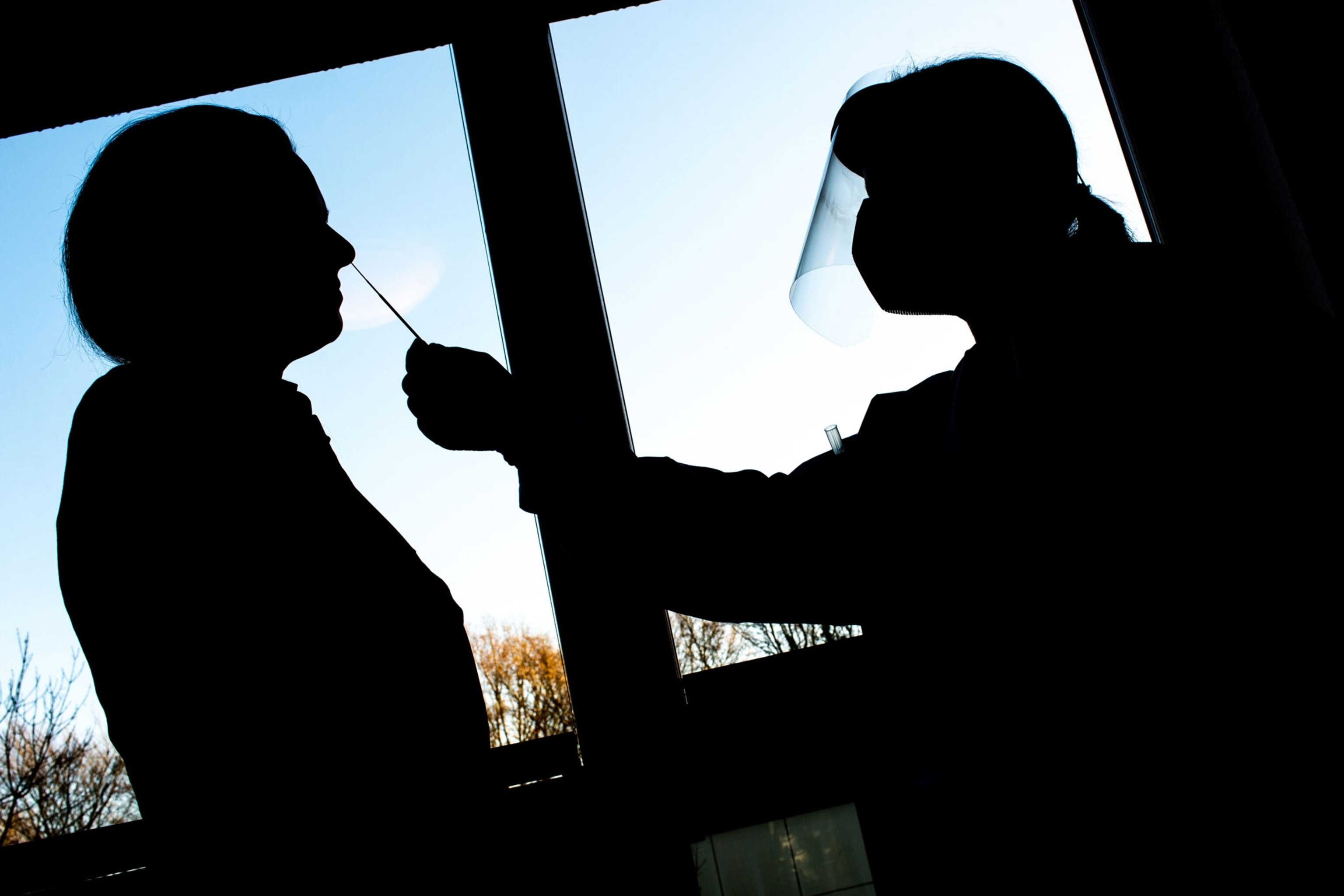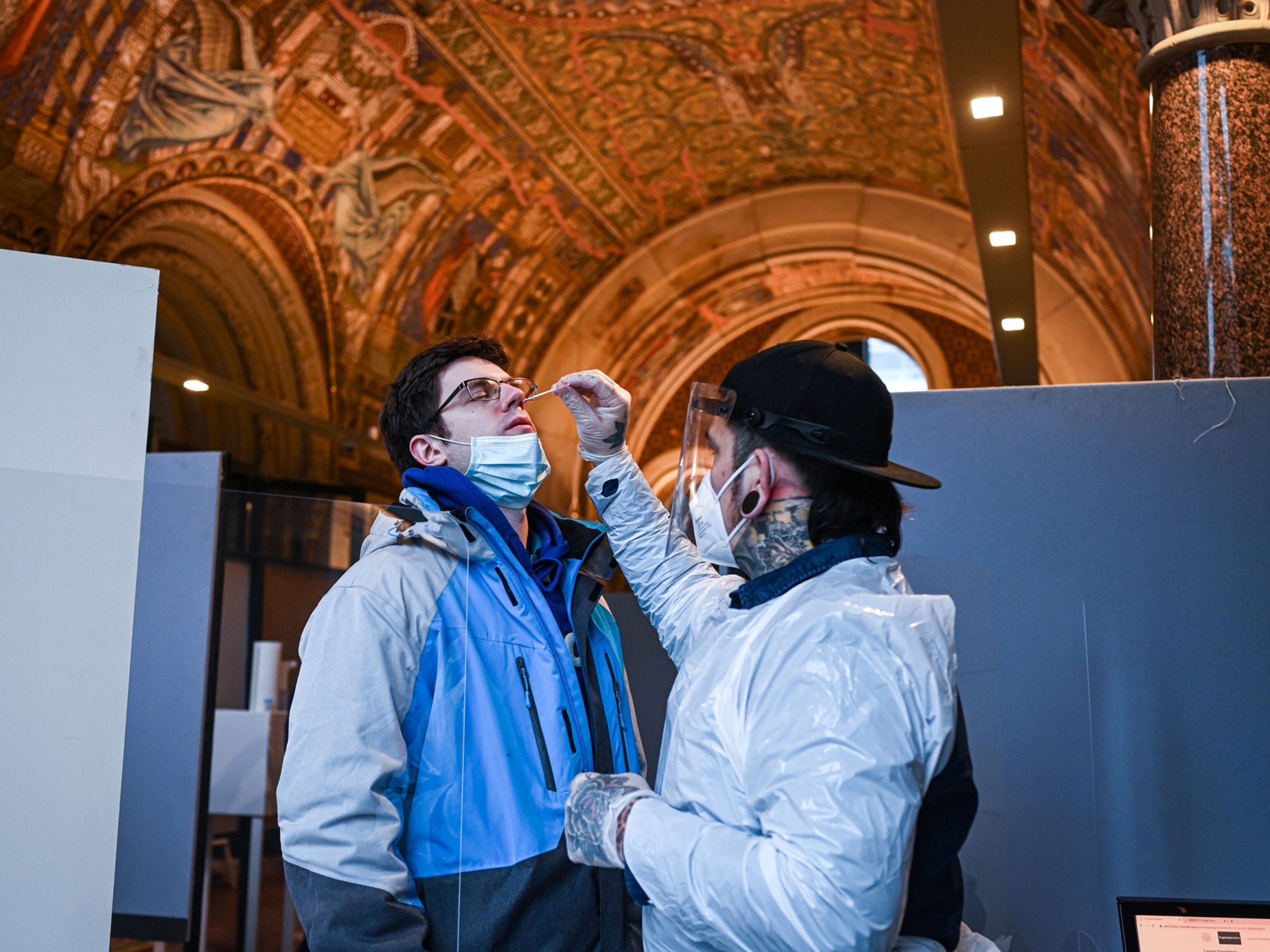
How good is COVID-19 testing in the U.S. right now?
One year ago, the first person in the U.S. tested positive for the coronavirus. Here’s what you need to know about testing today, and how it might change under new national leadership.
Last January, a man who had been visiting family in Wuhan, China, went to an urgent care clinic in the Seattle area complaining of a few days of coughing and fever. Local health officials, on the lookout after hearing of the spreading novel coronavirus, quickly coordinated with the Centers for Disease Control and Prevention to get the patient tested, which involved flying a sample across the country to the CDC lab in Atlanta.
The next day, January 20, 2020, marked the first positive COVID-19 test on U.S. soil.
Since then, almost 300 million coronavirus tests have been performed in the country, and the incoming Biden Administration has vowed to scale that up with federal coordination and more funding.
Testing is a key component of an effective response to a respiratory disease such as COVID-19. It identifies where the virus is circulating, and it informs when and where to implement interventions to stop transmission, including tracing and isolating.
In the United States, what’s the current state of COVID-19 testing? And what could testing look like in the future?
How much testing are we currently doing?
In March 2020, former U.S. president Donald Trump visited the CDC and said “anybody that needs a test can have a test.” That was not true at the time, but the situation has since improved.
“I think there's a general recognition that we're getting there, but it's still not quite there,” says Amesh Adalja, an infectious disease expert at the Johns Hopkins Center for Health Security in Maryland. “Even in the last couple of weeks, I had a friend in Texas who had symptoms and he was trying to get a PCR test and there were no appointments available.”
PCR stands for polymerase chain reaction, a biochemical technique that can amplify tiny amounts of genetic material of interest—here, a bit of the SARS-CoV-2 virus’s genetic material. Usually run in a lab setting, a PCR test is by far the most common form of the COVID-19 tests authorized for use in the U.S.
Mara Aspinall, who collaborates with the Rockefeller Foundation to survey the testing landscape, agrees that availability is improving but says it is only barely adequate currently. Aspinall estimates that, right now, there is capacity for about 250 million coronavirus tests to be completed per month in the U.S.
That could more than triple by April to more than 750 million tests per month, which Aspinall says should be enough for the country to get to a consistent national testing regime. But this would only occur if more manufacturers get their tests authorized for use by the Food and Drug Administration, says Aspinall, professor of practice of biomedical diagnostics at Arizona State University,.
There’s also another factor to consider, says Anette “Peko” Hosoi, a data scientist and modeler at MIT who co-developed an NIH-funded project that helps organizations plan their testing programs. “Right now, if you’re going to ask me what the long pole in the tent is, I would say it's the logistics of getting the people tested, rather than getting enough tests,” she says. More testing sites and options and better administration and communication— especially in hard-hit vulnerable communities—are necessary.
This tension between capacity and logistics is visible in the long lines stretching out of drive-up testing sites—for example, the site at Dodger Stadium in Los Angeles, in an area that’s currently experiencing one of the worst surges in the country.
How are turnaround times?
In addition to long waits to get a test, there has been much consternation about the lengthening waits to receive results. A national survey conducted in August found that people who tested positive waited an average of four days to get that news—about twice as long as recommendations from public health experts. Since then, wait times have improved.
We want the turnaround time to be one day ideally. The longer the turnaround time is, the less valuable the test is.Amesh Adalja, Johns Hopkins Center for Health Security
“Both of the largest lab companies, Quest and LabCorp, have said that they are running the vast majority of their tests within 48 hours,” Aspinall says.
In part, this is because the government reimbursement structure changed at the start of this year. Medicare will only pay testing companies the full $100 if they can report results “within two calendar days of the specimen being collected.” If they go beyond 48 hours, the companies are reimbursed $75.
“We want the turnaround time to be one day ideally,” Adalja says. “The longer the turnaround time is, the less valuable the test is.”
COVID-19 is most contagious within the first five days someone is sick. The faster you can turn around these tests, the faster people who receive positive results know they need to isolate to stop the chain of transmission.
Who can get tested?
Early on in the pandemic, when testing capacity was limited, CDC guidelines stated that priority should be given to patients showing symptoms and to people who had reason to believe they had been exposed, either through close contact or through travel.
But people can still be infectious even if they are not showing symptoms. A recent study estimates that 59 percent of transmissions come from asymptomatic people, which means wider screening of the general population could help stop transmission.
It’s now much easier to get a test even without symptoms—for instance, as part of pre-screening before traveling—but it’s still not a priority.
“There's no question we're not testing asymptomatic people enough,” Aspinall adds. “You could forgive people in March and April and May saying that we don't want to waste our test, what few we had, on asymptomatic people, but we are eons beyond that.”
What’s the status of rapid, at-home testing?
One way to help catch asymptomatic transmission would be through greater use of at-home tests.
Three such tests have been approved,”but some of them have constraints,” Adalja says. “One is their cost. The other is some of them require prescriptions.”
He advocates for the widespread use of cheap antigen tests, which are strip-based like pregnancy tests and give results in minutes. They aren’t as sensitive as the traditional lab PCR tests but should be able to accurately return a positive result for most people when they are infectious.
However, the FDA didn’t authorize a rapid antigen test for at-home use without a prescription until mid-December. Why are these supposedly simple tests taking so long to hit the market?
“PCR is more about the work in the lab and the personnel, where the antigen test is more about the manufacturing,” Aspinall says. Existing PCR lab procedures can be fairly easily switched to detect different pathogens, but manufacturing a rapid antigen test has to start from scratch.
They are on the way, Aspinall says: “I know that companies are working really hard to do it.”
Ultimately, having multiple approaches to and styles of testing, including at-home rapid testing, could help suppress transmission, Hosoi says: “There are good reasons to use all of the different kinds of tests, and we're going to need all of them.”
What does the future of testing look like?
The incoming Biden Administration is inheriting a pandemic in its most gruesome stage yet. But a national testing strategy, something the previous administration did not flesh out, is likely on the way, with promises of increased funding and coordination.
Adalja hopes some of the $50 billion earmarked for testing will be used on widespread at-home rapid testing. “I think it really needs to become the standard,” he says.
Improving testing in schools is also a major priority, since that will be key to keeping them open, Hosoi says. That’s because vaccines have not been tested on children, so they are unlikely to be used in youngsters soon, leaving schoolkids open to possible infection and transmission.
Aspinall also hopes that the FDA speeds up authorization of more tests and that manufacturers ramp up quickly. In the meantime, vaccine producers can keep cranking out doses and the Biden Administration could take on a larger role in getting those shots into arms.
There’s much to do, including increasing testing, to tackle this still-raging virus. A national strategy will be a welcome change, but it will require even more coordination. As President Joe Biden said in his inaugural address: “We must set aside politics and finally face this pandemic as one nation.”
Related Topics
You May Also Like
Go Further
Animals
- Octopuses have a lot of secrets. Can you guess 8 of them?
- Animals
- Feature
Octopuses have a lot of secrets. Can you guess 8 of them? - This biologist and her rescue dog help protect bears in the AndesThis biologist and her rescue dog help protect bears in the Andes
- An octopus invited this writer into her tank—and her secret worldAn octopus invited this writer into her tank—and her secret world
- Peace-loving bonobos are more aggressive than we thoughtPeace-loving bonobos are more aggressive than we thought
Environment
- This ancient society tried to stop El Niño—with child sacrificeThis ancient society tried to stop El Niño—with child sacrifice
- U.S. plans to clean its drinking water. What does that mean?U.S. plans to clean its drinking water. What does that mean?
- Food systems: supporting the triangle of food security, Video Story
- Paid Content
Food systems: supporting the triangle of food security - Will we ever solve the mystery of the Mima mounds?Will we ever solve the mystery of the Mima mounds?
- Are synthetic diamonds really better for the planet?Are synthetic diamonds really better for the planet?
- This year's cherry blossom peak bloom was a warning signThis year's cherry blossom peak bloom was a warning sign
History & Culture
- Strange clues in a Maya temple reveal a fiery political dramaStrange clues in a Maya temple reveal a fiery political drama
- How technology is revealing secrets in these ancient scrollsHow technology is revealing secrets in these ancient scrolls
- Pilgrimages aren’t just spiritual anymore. They’re a workout.Pilgrimages aren’t just spiritual anymore. They’re a workout.
- This ancient society tried to stop El Niño—with child sacrificeThis ancient society tried to stop El Niño—with child sacrifice
- This ancient cure was just revived in a lab. Does it work?This ancient cure was just revived in a lab. Does it work?
- See how ancient Indigenous artists left their markSee how ancient Indigenous artists left their mark
Science
- Jupiter’s volcanic moon Io has been erupting for billions of yearsJupiter’s volcanic moon Io has been erupting for billions of years
- This 80-foot-long sea monster was the killer whale of its timeThis 80-foot-long sea monster was the killer whale of its time
- Every 80 years, this star appears in the sky—and it’s almost timeEvery 80 years, this star appears in the sky—and it’s almost time
- How do you create your own ‘Blue Zone’? Here are 6 tipsHow do you create your own ‘Blue Zone’? Here are 6 tips
- Why outdoor adventure is important for women as they ageWhy outdoor adventure is important for women as they age
Travel
- This royal city lies in the shadow of Kuala LumpurThis royal city lies in the shadow of Kuala Lumpur
- This author tells the story of crypto-trading Mongolian nomadsThis author tells the story of crypto-trading Mongolian nomads
- Slow-roasted meats and fluffy dumplings in the Czech capitalSlow-roasted meats and fluffy dumplings in the Czech capital







